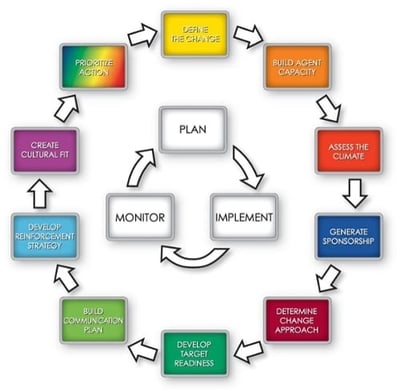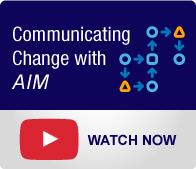Recently, we were working with a business leader in a large organization on a major initiative and we asked him what his plan was for implementation. His answer? “Oh, we’ve got that under control. We’ve got a project website set up, a focus group scheduled and an email campaign ready to go.” 
We get this type of response all the time. In fact, in our 35+ years of Change Management Consulting, one of the most common mistakes we see is when organizations, like this one, are fooled into thinking a communication plan is the same thing as an implementation plan. The truth of the matter is having a communication plan is important, but it is just one piece of a full change management plan.
What’s the Source of this Confusion?
There is a commonly held belief that if we just tell people about the change, and tell them more often it will be enough to get buy-in and even behavior change. This assumption is grounded in the belief that if people just understand the business logic and rationale behind a change they will get on board. Unfortunately, it is never this simple. Think of it this way, if we could change behavior just by communicating people wouldn't smoke and everyone would be at their ideal weight!
The second and related source of the confusion is the inherent (and misunderstood) belief that getting any change installed is the same thing as getting it implemented. It is easy to rely on communications alone if an organization stops at the point of installation (getting a change launched) rather than at the point of achieving adoption and Return on Investment. Installation is important, but not enough; a communication plan is important, but it is also not enough.
Third, when we look at the intersection of change management and project management, there is a general lack of knowledge about the critical elements that really must be a part of any true implementation plan.
Key Elements of an Implementation Plan
Is having a communication plan important? Absolutely. But, it’s not enough. A sound change management methodology like the Accelerating Implementation Methodology (AIM) certainly includes communication planning—but if you look at the AIM roadmap you will see communication is only one of the ten elements for managing the human side of organizational changes! 
When building a change implementation plan there are several key steps that must be addressed. At a minimum, a full implementation plan must include:
- A Business Case for Action: Gaining alignment on the scope and definition of the change, including the identification of the human objectives for the project, is an imperative first step in any implementation plan. There are four questions that must be commonly understood by everyone involved in the change. What are we changing? Why are we changing? What are the consequences for not changing? And how will the progress be measured?
- Generating Sponsorship: Sponsorship for change isn’t the responsibility of one individual. It is the responsibility of every individual who has direct reports that are impacted by the change. Change is accelerated when what these leaders say, do, and reinforce are all aligned and demonstrate commitment to the change. Every change implementation plan should have an explicit strategy for ensuring this level of commitment at the beginning, middle, and end of the project lifecycle.
- Developing Target Readiness: One of the mistakes organizations often make is waiting far too long to start to build readiness for a business change. Then building readiness becomes a reactive activity. Resistance is inevitable, and it’s a function of the level of work disruption—how many things are going to be different as a result of this change, and not whether a change is perceived to be positive or negative. It’s not logical, and it can’t be wished away. There are, however, pro-active steps organizations can take to identify the likely sources of resistance so that it can be better managed.
- Developing a Reinforcement Strategy: A best practice implementation plan must include a Reinforcement Strategy that aligns reinforcement mechanisms with the new performance expectations. In fact, the real power-lever in driving sustained behavior change is not communication at all… it’s changing the reinforcements that motivate people to leave the status quo!
- Building a Communication Plan: The AIM methodology centers communication efforts on delivering the right message to the right audience using the right communication vehicles, and always includes a feedback loop to gather reactions to both the content of the change, and how the change is being implemented.
Providing a clear path for the future with a full implementation plan helps create clarity out of the chaos that is so common in change. Communication is certainly one area to plan for, but it needs to be integrated with the other elements of a solid change management approach such as Defining the Change, Generating Sponsorship, Creating Readiness to manage resistance and Developing a Reinforcement Strategy. These core principles will guide your way through the technical, business and people-side of any change implementation.


